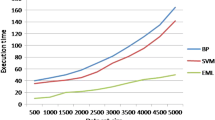Abstract
Support vector machines (SVMs) have been proved effective and promising techniques for classification problem. Recently, SVMs have been successfully applied to target diseases classification and prediction by using real-world data. In this paper, we propose a new quadratic kernel-free least squares support vector machine (QLSSVM) for binary classification problem. The model of QLSSVM is a convex quadratic programming problem with an advantage of kernel-free, compared with the existed least squares SVM. By using consensus technique, the decision variables of QLSSVM are split into local variable and global variable. Then the QLSSVM is converted into the consensus QLSSVM and solved by alternating direction method of multipliers with a Gaussian back substitution. Finally, our QLSSVM is illustrated in terms of numerical tests based on two types of training data sets. The first numerical test is implemented based on artificial data to certify the performance of our QLSSVM. To apply our QLSSVM to disease classification, the second one is implemented based on diseases data set from University of California, Irvine, Machine Learning Repository to demonstrates that our model has higher classification accuracy compared with several existed methods. In particularly, our numerical example is implemented based on a special heart disease data set provided by Hungarian heart disease database to illustrates the effectiveness of our QLSSVM for a particular disease diagnosis.










Similar content being viewed by others
References
Al-Bashish D, Bani-Ahmad S, Braik M (2011) Detection and classification of leaf diseases using k-means based segmentation and neural networks based classification. Inf Technol J 10(2):267–275
Baesensl B, Viaenel S, Van Gestel T, Suykens JA, Dedene G, De Moor B, Vanthienen J (2000) An empirical assessment of kernel type performance for least squares support vector machine classifiers. Fourth international conference on knowledge-based. lntelligent engineerg systems & allied technologies, vol 1, pp 313–316
Bai Y, Chen Y, Niu B (2013) New sdp models for protein homology detection with semi-supervised SVM. Optimization 62(4):561–572
Bai Y, Niu BL, Chen Y (2012) Sdp relaxation for semi-supervised support vector machine. Pac J Optim 8(1):3–14
Bai Y, Shen K, Shen Y (2014) Consensus proximal support vector machine for classification. J Oper Res Soc China 2:57–74
Boyd S, Parikh N, Chu E, Peleato B, Eckstein J (2010) Distributed optimization and statistical learning via the alternating direction method of multipliers. Found Trends Mach Learn 3:1–122
Chen W, Tian YJ (2010) \(l_{p}\) -norm proximal support vector machine and its applications. Proc Comput Sci 1:2417–2423
Cortes C, Vapnik V (1995) Support-vector networks. Mach Learn 20(3):273–297
Deng N, Zhang C, Tian Y (2012) Suppport vector machines: optimization based theory, algorithms and extensions. CRC Press, Boca Raton
Fung G, Mangasarian O (2001) Proximal support vector machine classifiers. In: Proceedings KDD-2001: knowledge discovery and data mining, San Francisco, pp 77–86
Gu G, Yuan X, He B (2014) Customized proximal point algorithms for linearly constrained convex minimization and saddle-point problems: a unified approach. Comput Optim Appl 59(1):135–161
Gu Y, Goh M, Chen QL, Souza RD, Tang GC (2013a) A new two-party bargaining mechanism. J Comb Optim 25(1):135–163
Gu Y, Fan J, Tang G, Zhong J (2013b) Maximum latency scheduling problem on two-person cooperative games. J Comb Optim 26(1):71–81
He B, Tao M, Yuan X (2012) Alternating direction method with gaussian back substitution for separable convex programming. SIAM J Optim 22(2):313–340
Huang K, Yang H, King I, Lyu MR, Chan L (2004) Biased minimax probability machine for medical diagnosis. Artif Intell Math, pp 111–118
Dagher I (2008) Quadratic kernel-free non-linear support vector machine. J Global Optim 41(1):15–30
Lathia J (2014) Modeling mayhem: predicting invasion and proliferation kinetics in idh1 mutant glioblastoma with mathematical models. Neuro-Oncology 16(6):763–764
Jayadeva J, Khemchandani R, Chandra S (2007) Twin support vector machines for pattern classification. IEEE Trans Pattern Anal Mach Intell 29(5):905–910
Liang Y, Liu C, Luan C, Leung KS, Chan TM, Xu ZB, Zhang H (2013) Sparse logistic regression with a \(l_{_{1/2}}\) penalty for gene selection in cancer classification. BMC Bioinf 14(1):198
Mangasarian O, Wild EW (2006) Multisurface proximal support vector machine classification via generalized eigenvalues. IEEE Trans Pattern Anal Mach Intell 28:69–74
Rani K (2011) Analysis of heart diseases dataset using neural network approach. Int J Data Min Knowl Manag Process 1(5):1–8
Rumpf T, Mahlein A, Steiner U, Oerke EC, Dehne HW, Plümer L (2010) Early detection and classification of plant diseases with support vector machines based on hyperspectral reflectance. Comput Electron Agric 74(1):91–99
Suykens JAK, Vandewalle J (1999) Least squares support vector machine classifiers. Neural Process Lett 9(3):293–300
Tian Y, Qi Z (2014) Review on: twin support vector machines. Ann Data Sci 1(2):253–277
Vapnik VN, Vapnik V (1998) Statistical learning theory. Wiley, New York
Zhong L, Luo S, Wu L, Xu L, Yang J, Tang G (2014) A two-stage approach for surgery scheduling. J Comb Optim 27(3):545–556
Zhou Z, Jiang Y (2004) Nec4.5: neural ensemble based c4.5. IEEE Trans Knowl Data Eng 16(6):770–773
Acknowledgments
This research was supported by a Grant from the National Natural Science Foundation of China (No.11371242).
Author information
Authors and Affiliations
Corresponding author
Rights and permissions
About this article
Cite this article
Bai, Y., Han, X., Chen, T. et al. Quadratic kernel-free least squares support vector machine for target diseases classification. J Comb Optim 30, 850–870 (2015). https://doi.org/10.1007/s10878-015-9848-z
Published:
Issue Date:
DOI: https://doi.org/10.1007/s10878-015-9848-z




